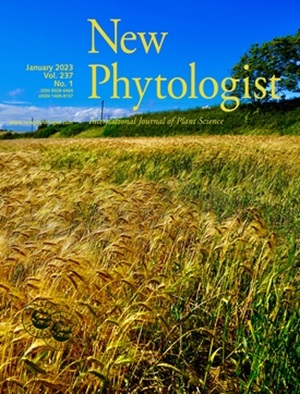The OsNLP3/4-OsRFL module regulates nitrogen-promoted panicle architecture in rice
IF 8.3
1区 生物学
Q1 PLANT SCIENCES
引用次数: 0
Abstract
- Rice panicles, a major component of yield, are regulated by phytohormones and nutrients. How mineral nutrients promote panicle architecture remains largely unknown.
- Here, we report that NIN-LIKE PROTEIN3 and 4 (OsNLP3/4) are crucial positive regulators of rice panicle architecture in response to nitrogen (N). Loss-of-function mutants of either OsNLP3 or OsNLP4 produced smaller panicles with reduced primary and secondary branches and fewer grains than wild-type, whereas their overexpression plants showed the opposite phenotypes.
- The OsNLP3/4-regulated panicle architecture was positively correlated with N availability. OsNLP3/4 directly bind to the promoter of OsRFL and activate its expression to promote inflorescence meristem development. Furthermore, OsRFL activates OsMOC1 expression by binding to its promoter.
- Our findings reveal the novel N-responsive OsNLP3/4-OsRFL-OsMOC1 module that integrates N availability to regulate panicle architecture, shedding light on how N nutrient signals regulate panicle architecture and providing candidate targets for the improvement of crop yield.
OsNLP3/4-OsRFL模块调节氮促进的水稻穗部结构。
水稻穗是产量的主要组成部分,受植物激素和营养物质的调节。矿物质营养素如何促进穗部结构在很大程度上仍是未知的。在这里,我们报道了NIN样蛋白3和4(OsNLP3/4)是水稻对氮(N)反应的穗结构的关键正调控因子。与野生型相比,OsNLP3或OsNLP4的功能缺失突变体产生更小的圆锥花序,初级和次级分枝减少,籽粒更少,而它们的过表达植物表现出相反的表型。OsNLP3/4调控的穗部结构与氮有效性呈正相关。OsNLP3/4直接与OsRFL的启动子结合并激活其表达以促进花序分生组织的发育。此外,OsRFL通过与其启动子结合来激活OsMOC1的表达。我们的研究结果揭示了新的氮响应OsNLP3/4-OsRFL-OsMOC1模块,该模块整合了氮的有效性来调节穗结构,揭示了氮营养信号如何调节穗结构并为提高作物产量提供了候选靶点。
本文章由计算机程序翻译,如有差异,请以英文原文为准。
求助全文
约1分钟内获得全文
求助全文
来源期刊

New Phytologist
生物-植物科学
自引率
5.30%
发文量
728
期刊介绍:
New Phytologist is an international electronic journal published 24 times a year. It is owned by the New Phytologist Foundation, a non-profit-making charitable organization dedicated to promoting plant science. The journal publishes excellent, novel, rigorous, and timely research and scholarship in plant science and its applications. The articles cover topics in five sections: Physiology & Development, Environment, Interaction, Evolution, and Transformative Plant Biotechnology. These sections encompass intracellular processes, global environmental change, and encourage cross-disciplinary approaches. The journal recognizes the use of techniques from molecular and cell biology, functional genomics, modeling, and system-based approaches in plant science. Abstracting and Indexing Information for New Phytologist includes Academic Search, AgBiotech News & Information, Agroforestry Abstracts, Biochemistry & Biophysics Citation Index, Botanical Pesticides, CAB Abstracts®, Environment Index, Global Health, and Plant Breeding Abstracts, and others.
 求助内容:
求助内容: 应助结果提醒方式:
应助结果提醒方式:


